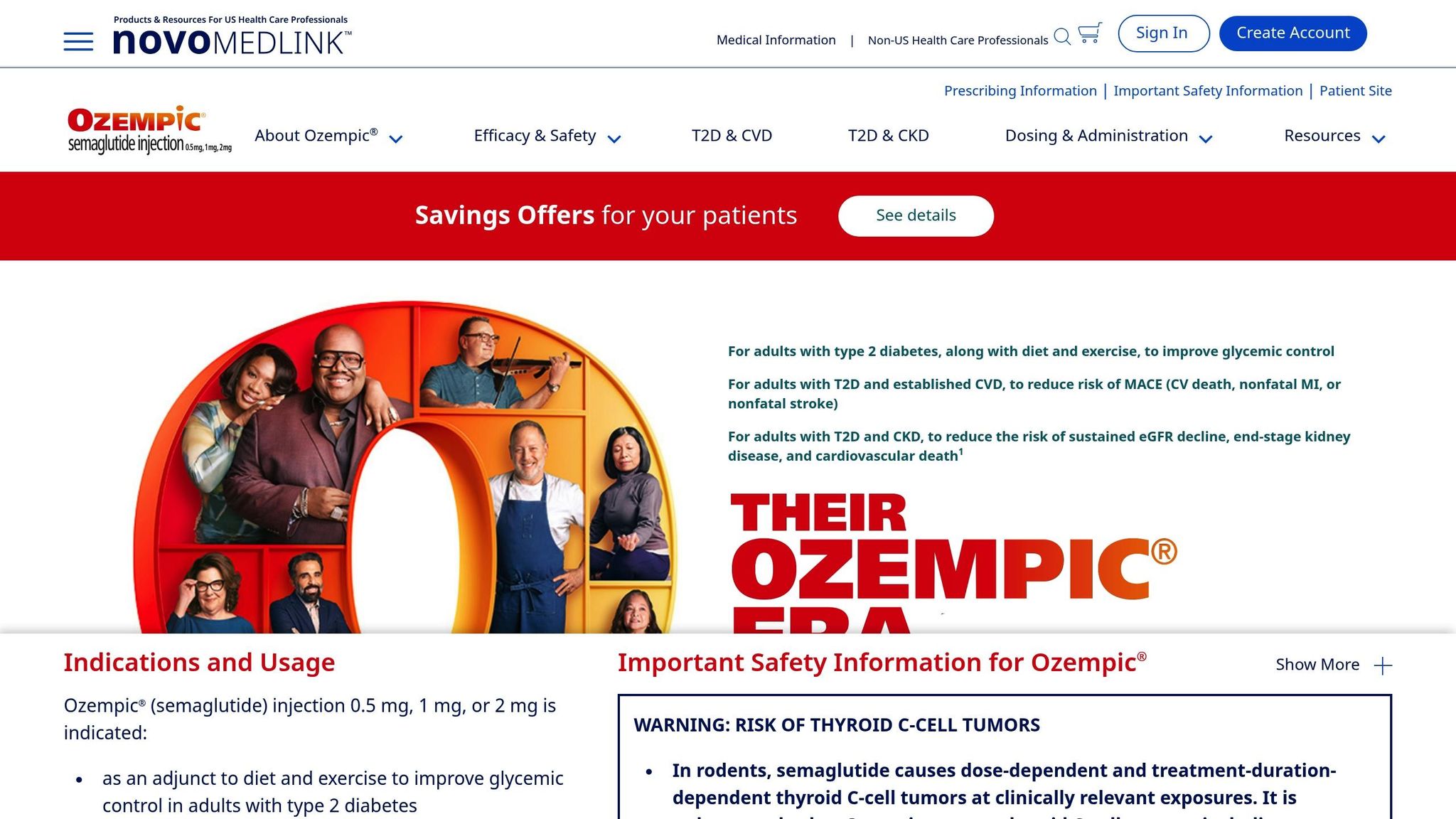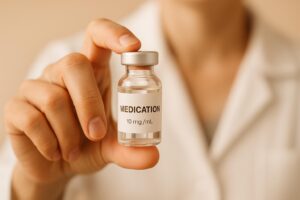Wegovy vs Ozempic: Complete Comparison

Wegovy and Ozempic are two medications that use the same active ingredient, semaglutide, but serve different purposes. Wegovy is FDA-approved for weight management, while Ozempic is primarily for type 2 diabetes, with weight loss as a secondary benefit. Here’s a quick breakdown:
- Wegovy: Targets obesity or overweight individuals (BMI ≥27 with health conditions). Higher dose (2.4 mg) for significant weight loss.
- Ozempic: Designed for adults with type 2 diabetes. Lower dose (up to 2.0 mg) focuses on blood sugar control and offers some weight loss.
Both are weekly injections, but Wegovy uses single-use pens, while Ozempic uses multi-dose pens. Side effects are similar, with gastrointestinal issues being more common in Wegovy users due to its higher dose. Pricing differs significantly: Wegovy costs about $1,579/month, while Ozempic is $1,149/month.
Quick Comparison:
| Criteria | Wegovy | Ozempic |
|---|---|---|
| Purpose | Weight management | Type 2 diabetes control |
| FDA Approval | Obesity/Overweight | Diabetes + Heart Disease |
| Max Dose | 2.4 mg | 2.0 mg |
| Side Effects | More frequent GI issues | Fewer GI issues |
| Cost (Monthly) | $1,579 | $1,149 |
Choosing the right option depends on your health goals. Consult your doctor to decide which is best for you.
Active Ingredients and FDA Approvals

Active Ingredient and How They Work
Wegovy and Ozempic share the same active ingredient: semaglutide. This compound is a GLP-1 receptor agonist, which mimics a hormone naturally produced in the intestines.
Both medications are administered using pre-filled injection pens on a once-weekly schedule. Semaglutide’s effects are multi-faceted: it binds to GLP-1 receptors in the pancreas, stomach, and brain. This triggers an increase in insulin release when blood sugar levels rise and reduces glucagon secretion, helping to prevent blood sugar spikes. Additionally, it slows digestion, which enhances feelings of fullness after meals, and interacts with appetite centers in the brain to reduce cravings and hunger.
The main difference between Wegovy and Ozempic lies in their dosing strengths and treatment goals. Each formulation is tailored with specific maximum doses to address distinct health concerns, which directly influences their FDA-approved uses.
FDA-Approved Uses
The variations in dosing and formulation result in different FDA-approved applications for these medications.
- Ozempic: Approved by the FDA in December 2017 for managing type 2 diabetes. In 2020, its approval expanded to include reducing the risk of major cardiovascular events – like heart attacks and strokes – in adults with type 2 diabetes and established heart disease.
- Wegovy: Approved in June 2021 for chronic weight management. It is intended for adults with obesity (BMI ≥30 kg/m²) or those who are overweight (BMI between 27 and 29.9 kg/m²) with at least one weight-related condition, such as high blood pressure, type 2 diabetes, or high cholesterol.
While Wegovy is specifically designed for weight management with higher doses to promote significant weight loss, Ozempic primarily addresses diabetes management, with weight loss as a secondary benefit.
Who Each Medication Is For
- Ozempic: Typically prescribed for adults with type 2 diabetes who need improved blood sugar control. It also offers added cardiovascular benefits for those with existing heart disease.
- Wegovy: Designed for adults with a BMI of 30 or higher, or those with a BMI between 27 and 29.9 who have weight-related conditions such as high blood pressure, sleep apnea, or elevated cholesterol.
Doctors determine which medication to prescribe based on the patient’s primary health concerns. The differences in dosing ensure that each individual receives the treatment most suited to their specific needs.
Dosing and How to Take Them
Weekly Doses
Both Wegovy and Ozempic are administered as once-weekly subcutaneous injections, making them more convenient compared to daily dosing. However, their maximum weekly doses differ based on their primary objectives.
- Wegovy: Designed specifically for weight loss, it reaches a maximum weekly dose of 2.4 mg.
- Ozempic: Primarily aimed at managing blood sugar levels in type 2 diabetes, its maximum weekly dose is 2.0 mg, while also offering weight loss benefits.
The delivery systems for these medications also differ. Wegovy uses single-dose, pre-filled pens with a built-in needle. Each pen delivers one dose and is disposed of after use. Ozempic, on the other hand, utilizes multi-dose pens that require attaching a new disposable needle for each injection. A single Ozempic pen provides multiple doses.
Next, let’s look at the titration schedules that set these treatments apart.
Starting Doses and Increases
To minimize gastrointestinal side effects, both medications follow a gradual titration schedule. The first 12 weeks are identical for both, but they diverge afterward.
| Timeline | Ozempic Dose | Wegovy Dose |
|---|---|---|
| Weeks 1-4 | 0.25 mg once weekly | 0.25 mg once weekly |
| Weeks 5-8 | 0.5 mg once weekly | 0.5 mg once weekly |
| Weeks 9-12 | 1.0 mg once weekly | 1.0 mg once weekly |
| Weeks 13-16 | 2.0 mg once weekly | 1.7 mg once weekly |
| Week 17+ | 2.0 mg (maintenance) | 2.4 mg (maintenance) |
Both medications start at 0.25 mg weekly to reduce the risk of gastrointestinal discomfort. Wegovy includes an additional step at 1.7 mg during weeks 13-16 before reaching its full maintenance dose of 2.4 mg. This extra step helps ease the transition to the higher dosage needed for weight management.
Storage and Injection Tips
After determining the right dose, proper storage and injection techniques are key to ensuring effectiveness and safety.
- Storage: Unopened pens should be kept refrigerated between 36°F and 46°F. Once opened, both medications can be stored at room temperature (up to 86°F) for up to 56 days.
- Injection Sites: Rotate injection sites between the abdomen, thigh, or upper arm to avoid tissue irritation.
For Ozempic, a new, sterile needle must be attached to the multi-dose pen for each injection. The pen includes a dose selector for accurate administration. Wegovy, with its single-use design, eliminates this step since each pre-filled pen comes with a built-in needle.
It’s important to note that neither medication should be mixed with insulin. However, if insulin is also part of your treatment plan, both can be injected in the same general area – just at different sites. Healthcare providers typically offer guidance on proper injection techniques to ensure safe and effective use.
Weight Loss Results
Clinical Trial Results
Clinical trials reveal that Wegovy leads to greater weight loss compared to Ozempic. Specifically designed for weight management, Wegovy has demonstrated significant weight reduction when compared to a placebo. Ozempic, on the other hand, is primarily used for diabetes treatment, with weight loss as a secondary effect. While Ozempic also achieves notable weight loss, the results tend to be slightly less pronounced than those seen with Wegovy.
Additionally, a higher percentage of patients taking Wegovy reach clinically meaningful weight loss milestones. These findings highlight the importance of individual factors that can influence treatment response.
What Affects How Well They Work
The effectiveness of these treatments depends on more than just the medication itself. Lifestyle habits and individual biology play a major role in shaping outcomes. Incorporating dietary changes and increasing physical activity are critical for achieving the best results.
Consistency is key. Sticking to the prescribed dosing schedule is crucial for replicating the weight loss results observed in clinical trials.
Other factors, like age, starting weight, overall metabolic health, and genetics, also influence outcomes. While some individuals may see more dramatic weight loss in absolute terms, the percentage of weight lost tends to be similar across different groups.
Pre-existing medical conditions can also impact effectiveness. For instance, people with insulin resistance or prediabetes may experience more pronounced benefits, while certain medications – like corticosteroids or antipsychotics – might reduce the treatment’s effectiveness.
Weight loss with these treatments happens gradually, and staying consistent with the regimen is essential for long-term success.
Lastly, support from healthcare providers can make a big difference. Regular check-ins, adjustments to the treatment plan, and help with managing side effects all contribute to better overall results.
Side Effects and Safety
Common Side Effects
Wegovy and Ozempic both contain semaglutide, which means they share similar side effects. However, the frequency and severity can differ due to Wegovy’s higher maximum dosage, which often leads to more gastrointestinal issues.
Digestive discomfort is the most frequently reported problem for users of both medications. For instance, 73% of Wegovy users reported stomach-related side effects, compared to 36% of Ozempic users. This difference highlights the impact of the higher doses used for weight management versus diabetes treatment.
| Side Effect | Wegovy (2.4 mg dose) | Ozempic (1 mg dose) |
|---|---|---|
| Nausea | 44% | 20% |
| Diarrhea | 30% | 9% |
| Vomiting | 24% | 9% |
| Constipation | 24% | 3% |
| Abdominal pain | 20% | 6% |
Most of these side effects are mild and tend to subside over time as your body adjusts. To help with this, both medications are introduced at low doses and gradually increased, giving your digestive system time to adapt.
However, beyond these common side effects, there are also more serious risks to consider.
Serious Risks and FDA Warnings
While these medications offer benefits, they come with important safety warnings. Both Wegovy and Ozempic include an FDA-mandated boxed warning about the potential risk of thyroid cancer. This is the most serious warning the FDA can issue for prescription drugs.
Another significant concern is pancreatitis, an inflammation of the pancreas that can cause intense abdominal pain and requires immediate medical attention. Gallbladder issues are also possible, with 2.8% of patients in clinical trials experiencing gallbladder-related problems.
In a four-year trial for Wegovy, 16.6% of participants stopped the medication due to adverse events, compared to 8.2% in the placebo group. Additionally, gastrointestinal issues like nausea and vomiting affected 10% of Wegovy users, compared to just 2% of those on placebo.
When to Call Your Doctor
Staying safe while using these medications means knowing when to reach out to your healthcare provider. If side effects become bothersome or persistent, don’t hesitate to contact your doctor for advice.
If you experience mild allergic reactions, such as a rash, let your doctor know. They can recommend treatments to manage your symptoms and assess whether you should continue the medication.
For severe allergic reactions – like swelling or difficulty breathing – call 911 immediately. These symptoms are potentially life-threatening and require urgent care.
If you notice signs of thyroid cancer, such as hoarseness that doesn’t go away, trouble swallowing, or a lump in your neck, contact your doctor as soon as possible. While these symptoms don’t always indicate cancer, they need to be checked out.
Other symptoms that warrant immediate medical attention include severe abdominal pain that doesn’t improve, persistent vomiting that prevents you from staying hydrated, or signs of pancreatitis. If mild side effects linger for more than a few days or worsen, consult your doctor or pharmacist for guidance.
sbb-itb-e2779c3
What Is The Difference Between Semaglutide Ozempic and Wegovy?

Cost and Getting Access
Now that we’ve covered side effects and safety, let’s talk about pricing and how to get access.
Pricing and Insurance Coverage
Wegovy comes with a monthly price tag of $1,579, while Ozempic costs $1,149 per month. That’s a difference of $430 each month – or over $5,000 annually. Pricing can vary, so it’s a good idea to check with your insurance provider and consult your healthcare team for specific coverage details.
Getting Help with Access and Support
TrimRX provides personalized weight loss programs designed to align with your health goals and budget. These programs include free delivery, customized dosing, and unlimited professional check-ins to ensure ongoing support.
Additionally, TrimRX offers GLP-1 Daily Support supplements for $119, which can be a helpful addition to your weight management plan.
Which One Is Right for You
Choosing between Wegovy and Ozempic depends on your health needs, medical history, and treatment goals. Let’s break it down to help you figure out which one might suit you better.
Different Patient Types
- Wegovy: Designed for individuals prioritizing weight management. If weight loss is your primary goal, this is often the go-to option.
- Ozempic: Approved for managing type 2 diabetes while also aiding in weight loss. If you’re looking to manage diabetes and lose weight, Ozempic could be the better fit.
Once you’ve identified which patient profile matches your situation, the next step is to consult your doctor for tailored advice.
Working with Your Doctor
Your healthcare provider plays a crucial role in this decision. They’ll evaluate your medical history, treatment goals, and overall health plan to recommend the best option for you. Beyond prescribing the right medication, your doctor can guide you on incorporating lifestyle changes like diet and exercise. They’ll also help you navigate potential side effects and assist with insurance-related concerns to ensure a smooth treatment process.
Conclusion
Wegovy and Ozempic both rely on semaglutide but serve different purposes. Wegovy is designed for weight management, specifically for adults dealing with obesity or being overweight, while Ozempic focuses on managing type 2 diabetes, with weight loss as a secondary benefit.
The two medications differ in dosing schedules, FDA approvals, and their intended patient groups. Wegovy uses higher doses to enhance weight loss results, whereas Ozempic sticks to lower doses suitable for controlling blood sugar levels in diabetes. Both share similar side effects, with gastrointestinal discomfort being the most common during the initial stages of treatment.
Insurance coverage and costs can vary significantly between the two, which may impact long-term affordability. Deciding on the right option involves weighing effectiveness, cost, and personal health needs.
It’s essential to consult a healthcare provider who can evaluate your medical history, current conditions, and treatment goals. Be sure to discuss possible side effects and set realistic expectations together.
Keep in mind, these medications are most effective when paired with a healthy diet and regular exercise. Work with your doctor to determine the best treatment plan that fits your goals and circumstances for sustainable results.
FAQs
What should I consider when deciding between Wegovy and Ozempic for weight loss or diabetes management?
When choosing between Wegovy and Ozempic, the decision often comes down to your specific health priorities. Wegovy is FDA-approved specifically for weight loss and is prescribed at a higher dose to target this goal. In contrast, Ozempic is primarily designed to manage type 2 diabetes, with weight loss being a possible secondary effect.
Your doctor will take into account your medical history, current medications, and overall health needs to recommend the best option for you. It’s essential to discuss your goals and concerns with your healthcare provider to ensure the medication aligns with your individual needs.
What are the differences in side effects between Wegovy and Ozempic, and what should I do if I experience severe symptoms?
Wegovy and Ozempic share common side effects, including nausea, vomiting, diarrhea, constipation, and stomach pain. Since Wegovy is often prescribed at a higher dose, some people may find its side effects more intense.
If you notice severe symptoms like sharp abdominal pain, ongoing nausea, or signs of an allergic reaction, reach out to your doctor immediately. Staying in close communication with your healthcare provider can help address any issues and decide if changes to your treatment plan are necessary.
How do diet and exercise improve the results of Wegovy or Ozempic?
Incorporating a well-rounded diet and regular physical activity alongside Wegovy or Ozempic can make a big difference in achieving weight loss goals. These lifestyle adjustments not only help create a calorie deficit but also boost metabolism and encourage lasting healthy habits.
To maximize results, prioritize nutrient-rich foods, practice portion control, and engage in consistent physical activities like walking, strength training, or any exercise you enjoy. Pairing these efforts with the medication can promote more sustainable weight loss and contribute to overall well-being.
Related Blog Posts

Transforming Lives, One Step at a Time
Keep reading
Ultimate Guide to Semaglutide Dose Customization
This guide explores semaglutide dosing for diabetes and weight loss, emphasizing personalized adjustments for optimal results.
6 Common Drug Interactions with GLP-1 Medications
Learn about six common drug interactions with GLP-1 medications and how to manage potential risks for safe treatment.
Mounjaro Insurance Coverage: What to Know
Learn how insurance coverage for Mounjaro varies based on diabetes treatment and weight loss, along with tips for approval and cost-saving options.
Semaglutide vs. Tirzepatide: Max Dose
Explore the differences between two weight loss medications, their maximum doses, effectiveness, and safety profiles for better health outcomes.
GLP-1 Diet Plan: 7-Day Meal Guide
Learn how to effectively pair GLP-1 medications with nutritious meal planning for weight loss, improved digestion, and stable blood sugar.
Nausea and GLP-1 Medications: Solutions That Work
Learn effective strategies to manage nausea from GLP-1 medications, including dietary tips and the importance of personalized dosing.
5 Signs GLP-1 Medication Is Working for You
Learn the key signs that indicate your GLP-1 medication is effectively aiding weight loss, appetite control, and blood sugar management.
Plateau Problems: Restarting Weight Loss
Stalled weight loss on GLP-1 medications is common but manageable. Explore strategies to break through plateaus and regain momentum.
Body Fat Percentage Estimator – Know Your Stats
Estimate your body fat percentage in seconds with our free tool. Just input your height, weight, and more for instant results. Try it now!









